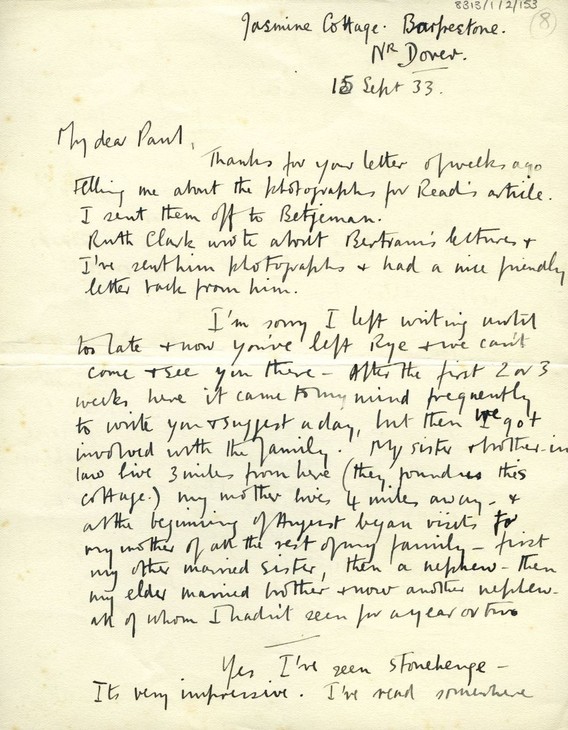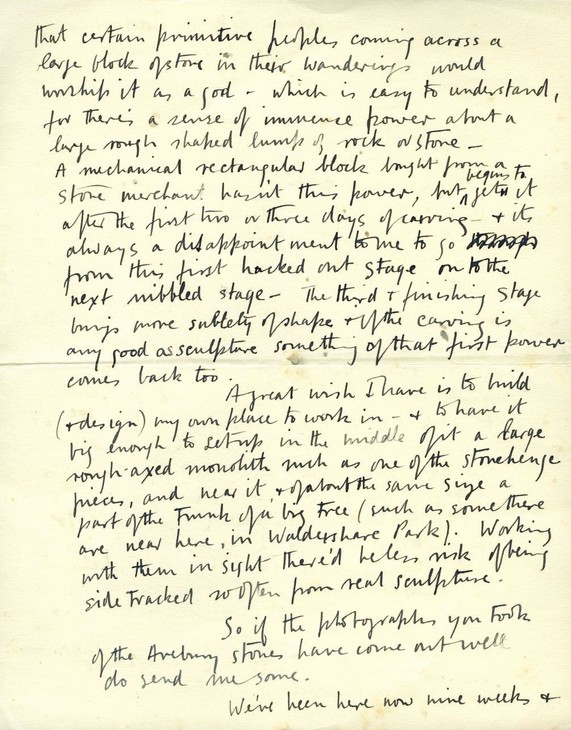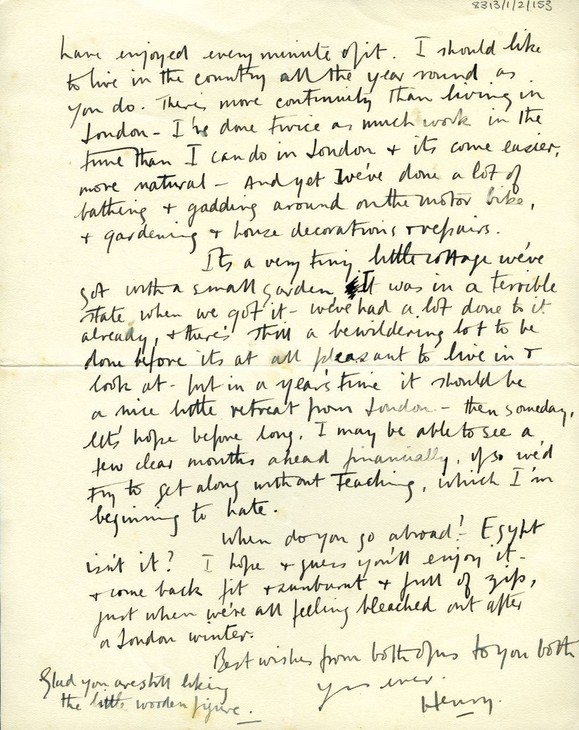Henry Moore Letter to Paul Nash 15 September 1933
Like his close friend and artistic collaborator Paul Nash, Henry Moore was fascinated by Britain’s pre-historic monuments. On 15 September 1933 Moore responded to a query from Nash, stating, ‘Yes. I’ve seen Stonehenge. It’s very impressive. I’ve read somewhere that certain primitive peoples coming across a large block of stone in their wanderings would worship it as a god – which is easy to understand, for there’s a sense of immense power about a large rough-shaped lump of rock or stone’. Moore had first visited the ancient standing stones of Stonehenge in 1921, and the experience of seeing them in moonlight left an indelible memory. Moore returned to the subject in 1973, creating a series of fifteen lithographic prints depicting the stones.
Transcript
[Handwritten:]
Jasmine Cottage. Barfrestone
Nr Dover.
15 Sept 33.
Nr Dover.
15 Sept 33.
My dear Paul,
Thanks for your letter of weeks ago telling me about the photographs for Read’s article. I sent them off to Betjeman.
Ruth Clark wrote about Bertram’s lectures and I’ve sent him photographs and had a nice friendly letter back from him.
I’m sorry I left writing until too late and now you’ve left Rye and we can’t come and see you there – After the first 2 or 3 weeks here it came to my mind frequently to write you and suggest a day, but then I’ve got involved with the family. My sister and brother-in-law live 3 miles from here (they found us this cottage). My mother lives 4 miles away – and at the beginning of August began visits to my mother of all the rest of my family – first my other married sister, then a nephew – then my elder married brother and now another nephew all of whom I hadn’t seen for a year or two.
– – –
Yes I’ve seen Stonehenge – It’s very impressive. I’ve read somewhere [end of p.1] that certain primitive peoples coming across a large block of stone in their wanderings would worship it as a god – which is easy to understand, for there’s a sense of immense power about a large rough shaped lump of rock or stone – A mechanical rectangular block brought from a stone merchant hasn’t this power, but begins to get it after the first two or three days or carving – And it’s always a disappointment to me to go from this first hacked out stage on to the next nibbled stage – The third and finishing stage brings more subtlety of shape and if the carving is any good as sculpture something of that first power comes back too.
A great wish I have is to build (and design) my own place to work in – and to have it big enough to set up in the middle of it a large rough-axed monolith much as one of Stonehenge pieces, and near it, and of about the same size a part of the trunk of big tree (such as some there are near here, in Waldershare Park). Working with them in sight there’d be less risk of being sidetracked so often from real sculpture.
So if photographs you took of the Avebury stones have come out well do send me some.
We’ve been here now nine weeks and [end of p.2] have enjoyed every minute of it. I should like to live in the country all the year round as you do. There’s more continuity than living in London – I’ve done twice as much work in the time than I can do in London and it’s come easier, more natural – And yet I’ve done a lot of bathing and gadding around on the motorbike, and gardening and house decorations and repairs.
It’s a very tiny little cottage we’ve got with a small garden. It was in a terrible state when we got it – we’ve had lot done to it already, and there’s still a bewildering lot to be done before it’s at all pleasant to live in and look at – but in a year’s time it should be a nice little retreat from London – then someday, let’s hope before too long, I may be able to see a few clear months ahead financially. If so we’d try to get along without teaching, which I’m beginning to hate.
When do you go abroad? Egypt isn’t it? I hope and guess you’ll enjoy it – and come back fit and sunburnt and full of zip, just when we’re all feeling bleached out after a London winter.
Best wishes from both of us to you both.
Yours ever
Henry
[Note in margin] Glad you are still liking the little wooden figure.
How to cite
Henry Moore, Letter to Paul Nash, 15 September 1933, in Henry Moore: Sculptural Process and Public Identity, Tate Research Publication, 2015, https://www



